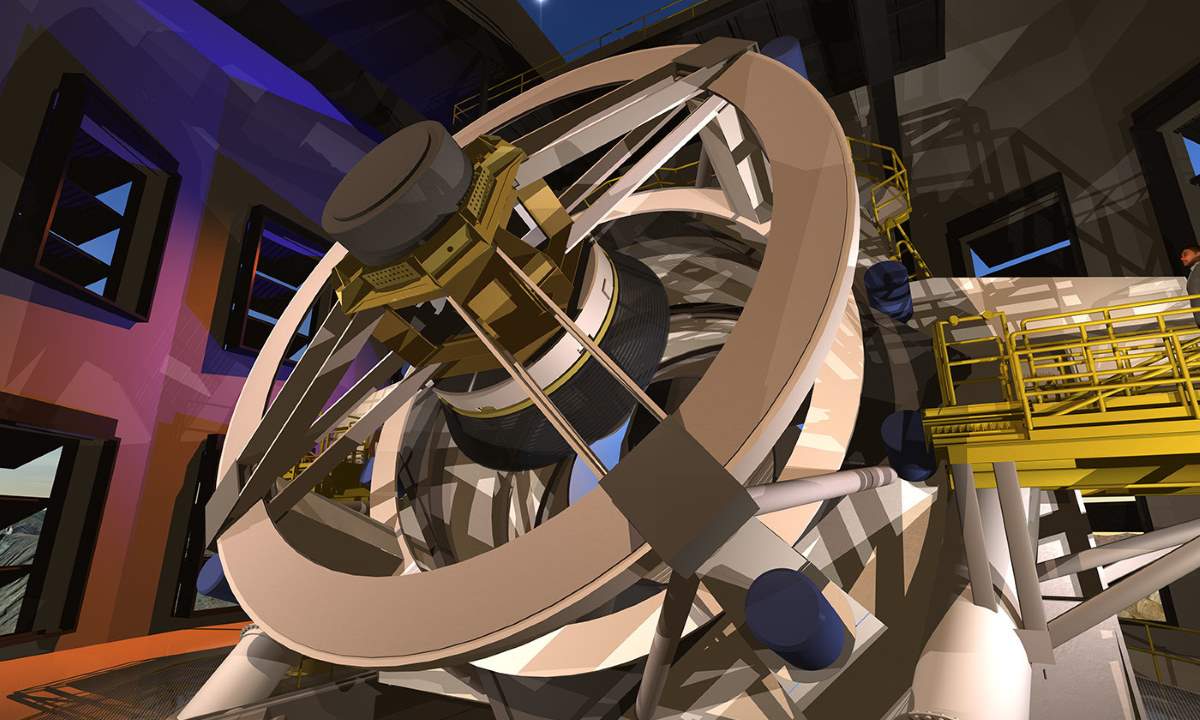The Giant Magellan Telescope (GMT) is a ground-based extremely large telescope under construction, planned for completion in 2025. When completed, it will be the world’s largest telescope and one member of the next class of giant ground-based telescopes that promises to revolutionize our view and understanding of the universe. It will be constructed in the Las Campanas Observatory in Chile.
GMT has a unique design that offers several advantages. It is a segmented mirror telescope that employs seven of today’s largest stiff monolith mirrors as segments. Six off-axis 8.4 meter or 27-foot segments surround a central on-axis segment, forming a single optical surface 24.5 meters, or 80 feet, in diameter with a total collecting area of 368 square meters. The GMT will have a resolving power 10 times greater than the Hubble Space Telescope!
Giant Magellan Telescope’s giant mirrors are made at the Richard F. Caris Mirror Lab at the University of Arizona in Tucson. They are a marvel of modern engineering and glassmaking; each segment is curved to a very precise shape and polished to within a wavelength of light-approximately one-millionth of an inch. The IEEE Spectrum channel published an amazing video on Youtube showing the manufacturing process of these mirrors.
Giant Magellan Telescope
The Giant Magellan Telescope will use seven of the world’s largest mirrors as primary mirror segments, each 8.417 m (27.61 ft) in diameter. These segments will then be arranged with one mirror in the center and the other six arranged symmetrically around it. The challenge is that the outer six mirror segments will be off-axis, and although identical to each other, will not be individually radially symmetrical, necessitating a modification of the usual polishing and testing procedures.
The casting of the first mirror, in a rotating furnace, was completed on November 3, 2005, but the grinding and polishing were still going on 6-and-a-half years later when the second mirror was cast, on 14 January 2012. A third segment was cast in August 2013, and the fourth in September 2015. The casting of each mirror uses 20 tons of E6 borosilicate glass from the Ohara Corporation of Japan and takes about 12-13 weeks. After being cast, they need to cool for about six months.
Once cooled, massive machinery lifts the mirror and tilts it to a vertical position. Engineers purge the ceramic mold from the mirror, wait for it to dry, and then rotate it again. They grind and refine the back of the mirror with exacting precision. Then they reposition the mirror in order to shape and polish the front face to within 20 nanometers of perfection, a process that takes about 18 months. Along the way, it undergoes four optical tests, some of which were engineered specifically for this project.

Adaptive Optics
How newly designed giant ground-based telescopes can outperform the Hubble Space Telescope, despite its orbit is outside the distortion of Earth’s atmosphere and there is substantially lower background light up there?
Because new telescopes will be outfitted with a cutting-edge technology called adaptive optics. This technology was first attached to two twin telescopes the Gemini Observatory (in Hawaii and Chile), to outperform the Hubble Space Telescope in a side-by-side comparison.
Hubble Space Telescope was launched on April 24, 1990, and entered service on May 20, 1990. It still remains in operation and can take extremely high-resolution images compared to most of the current ground-based telescopes.
Adaptive optics (AO) is a technology used to improve the performance of optical systems by reducing the effect of incoming wavefront distortions by deforming a mirror in order to compensate for the distortion. It is used in astronomical telescopes and laser communication systems to remove the effects of atmospheric distortion, in microscopy, optical fabrication, and retinal imaging systems to reduce optical aberrations.
Adaptive optics works by measuring the distortions in a wavefront and compensating for them with a device that corrects those errors such as a deformable mirror or a liquid crystal array.
The technology was first envisioned by the American astronomer Horace W. Babcock (September 13, 1912 – August 29, 2003) in 1953, and was also considered in science fiction, as in the American science fiction author Poul Anderson’s (November 25, 1926 – July 31, 2001) novel Tau Zero (1970), but it did not come into common usage until advances in computer technology during the 1990s made the technique practical.
Sources
- Giant Magellan Telescope on Wikipedia
- Giant Magellan Telescope official website
- “Casting a $20 Million Mirror for the World’s Largest Telescope” on IEEE Spectrum website
- “This Is How Astronomy Is Finally Defeating Its Greatest Enemy: Earth’s Atmosphere” by Ethan Siegel on Medium
- Adaptive Optics on Wikipedia
- Space Shuttle Endeavour’s Touchdown Meets Columbia’s Salute [An amazing photo from the past] - February 29, 2024
- Moon Landings: All-Time List [1966-2024] - February 23, 2024
- From Orbit to Ordinary: 10 Earthly Applications of Space Technology - January 23, 2024


